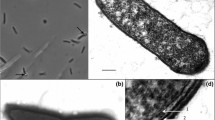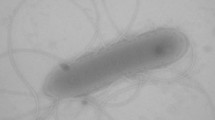Abstract
A novel moderately thermophilic bacterium, strain STGHT, was isolated from Severo-Stavropolskoye underground gas storage (Russia). Cells of strain STGHT were spore-forming motile straight rods 0.3 μm in diameter and 2.0–4.0 μm in length having a Gram-positive cell wall structure. The temperature range for growth was 36–65 °C, with an optimum at 50–52 °C. The pH range for growth was 5.5–8.0, with an optimum at pH 7.0–7.5. Growth of strain STGHT was observed at NaCl concentrations ranging from 0 to 4.0 % (w/v) with an optimum at 1.0 % (w/v). Strain STGHT grew anaerobically by reduction of nitrate, thiosulfate, S0 and AQDS using a number of complex proteinaceous compounds, organic acids and carbohydrates as electron donors. Nitrate was reduced to nitrite; thiosulfate and sulfur were reduced to sulfide. It also was able to ferment pyruvate, glucose, fructose, and maltose. The strain STGHT did not grow under aerobic conditions during incubation with atmospheric concentration of oxygen but was able to microaerobic growth (up to 10 % of oxygen in gas phase). The G+C content of DNA of strain STGHT was 34.8 mol%. 16S rRNA gene sequence analysis revealed that the isolated organism belongs to the class Bacilli. We propose to assign strain STGHT to a new species of a novel genus Tepidibacillus fermentans gen. nov., sp.nov. The type strain is STGHT (=DSM 23802T, =VKM B-2671T).


Similar content being viewed by others
References
Balk M, van Gelder T, Weelink SA, Stams AJM (2008) (Per)chlorate reduction by the thermophilic bacterium Moorella perchloratireducens sp.nov., isolated from underground gas storage. Appl Environ Microbiol 74:403–409
Balk M, Mehboob F, van Gelder AH, Rijpstra WIC, Damsté JSS, Stams AJM (2010) (Per)chlorate reduction by an acetogenic bacterium, Sporomusa sp., isolated from an underground gas storage. Environ Biotechnol 88:595–603
Basso O, Lascourreges J-F, Le Borgne F, Le Goff C, Magot M (2009) Characterization by culture and molecular analysis of the microbial diversity of a deep subsurface gas storage aquifer. Res Microbiol 160:107–116
Ben-Hania W, Postec A, Aüllo T, Ranchou-Peyruse A, Erauso G, Brochier-Armanet C, Hamdi M, Ollivier B, Saint-Laurent S, Magot M, Fardeau M-L (2013) Mesotoga infera sp. nov., a novel mesophilic member of the order Thermotogales, isolated from an underground gas storage in France. Int J Syst Evol Microbiol. doi:10.1099/ijs.0.047993-0
Benson DA, Boguski MS, Lipman DJ, Oullette BFF, Rapp BA, Wheeler DL (1999) GenBank. Nucleic Acids Res 27:12–17
Bonch-Osmolovskaya EA, Sokolova TG, Kostrikina NA, Zavarzin GA (1990) Desulfurella acetivorans gen. nov. and sp.nov.—a new thermophilic sulfur-reducing eubacterium. Arch Microbiol 153:151–155
Christie WW (2011) Thin-layer chromatography of lipids. http://lipidlibrary.aocs.org/topics/tlc/index.htm
Collins MD (1985) Analysis of isoprenoid quinones. Methods Microbiol 18:329–366
Ivanova AE, Borzenkov IA, Tarasov AL, Milekhina EI, Belyaev SS (2007) A microbiological study of an underground gas storage in the process of gas injection. Microbiology 76:453–460
Khelifi N, Romdhane EB, Hedi A, Postec A, Fardeau M-L, Hamdi M, Tholozan J-L, Ollivier B, Hirschler-Réa A (2010) Characterization of Microaerobacter geothermalis gen. nov., sp. nov., a novel microaerophilic, nitrate- and nitrite-reducing thermophilic bacterium isolated from a terrestrial hot spring in Tunisia. Extremophiles 14:207–304
Kim OS, Cho YJ, Lee K, Yoon SH, Kim M, Na H, Park SC, Jeon YS, Lee JH, Yi H, Won S, Chun J (2012) Introducing EzTaxon-e: a prokaryotic 16S rRNA Gene sequence database with phylotypes that represent uncultured species. Int J Syst Evol Microbiol 62:716–721
Klouche N, Basso O, Lascourrèges JF, Cayol JL, Thomas P, Fauque G, Fardeau ML, Magot M (2009) Desulfocurvus vexinensis gen. nov., sp. nov., a sulfate-reducing bacterium isolated from a deep subsurface aquifer. Int J Syst Evol Microbiol 59:3100–3104
L’Haridon S, Miroshnichenko ML, Kostrikina NA, Tindall BJ, Spring S, Schumann P, Stackebrandt E, Bonch-Osmolovskaya EA, Jeanthon C (2006) Vulcanibacillus modesticaldus gen. nov., sp. nov., a strictly anaerobic, nitrate-reducing bacterium from deep-sea hydrothermal vents. Int J Syst Evol Microbiol 56:1047–1053
Marmur J (1961) A procedure for the isolation of deoxyribonucleic acid from microorganisms. J Mol Biol 3:208–218
Marmur J, Doty P (1962) Determination of the base composition of deoxyribonucleic acid from its thermal denaturation temperature. J Mol Biol 4:109–118
Sasser M (1990) Identification of bacteria by gas chromatography of cellular fatty acids. MIDI Technical Note 101. MIDI Inc, Newark
Slobodkin A, Reysenbach A-L, Strutz N, Dreier M, Wiegel J (1997) Thermoterrabacterium ferrireducens gen. nov., sp. nov., a thermophilic anaerobic dissimilatory Fe(III)-reducing bacterium from a continental hot spring. Int J Syst Bacteriol 47:541–547
Slobodkin AI, Tourova TP, Kuznetsov BB, Kostrikina NA, Chernyh NA, Bonch-Osmolovskaya EA (1999) Thermoanaerobacter siderophilus sp. nov., a novel dissimilatory Fe(III)-reducing anaerobic thermophilic bacterium. Int J Syst Bacteriol 49:1471–1478
Slobodkina GB, Kolganova TV, Kostrikina NA, Bonch-Osmolovskaya EA, Slobodkin AI (2012) Caloribacterium cisternae gen. nov., sp. nov., an anaerobic thermophilic bacterium from an underground gas storage reservoir. Int J Syst Evol Microbiol 62:1543–1547
Tamura K, Peterson D, Peterson N, Stecher G, Nei M, Kumar S (2011) MEGA5: Molecular Evolutionary Genetics analysis using maximum likelihood, evolutionary distance, and maximum parsimony methods. Mol Biol Evol 28:2731–2739
Tarasov AL, Borzenkov IA, Chernykh NA, Belyayev SS (2011) Isolation and investigation of anaerobic microorganisms involved in methanol transformation in an underground gas storage facility. Microbiology 80:172–179
Tindall BJ (1990) Lipid composition of Halobacterium lacusprofundi. FEMS Microbiol Lett 66:199–202
Vaskovsky VE, Kostetsky EY (1968) Modified spray for the detection of phospholipids on thin-layer chromatograms. J Lipid Res 9:396
Wolin EA, Wolin MJ, Wolfe RS (1963) Formation of methane by bacterial extracts. J Biol Chem 238:2882–2886
Acknowledgments
This work was supported by Programs “Molecular and cell biology” and “The origin and evolution of the biosphere” of the Russian Academy of Sciences and by project 14.B37.21.1489 and contracts № 11.519.11.2029 and 14.512.11.0070 from the Ministry of Education and Science of Russia. We are grateful to Drs. I. Borzenkov and A. Tarasov for providing samples and for consultations.
Author information
Authors and Affiliations
Corresponding author
Additional information
Communicated by M. da Costa.
The GenBank/EMBL accession number of the 16S rRNA gene sequence of strain STGHT is KC242245.
Electronic supplementary material
Below is the link to the electronic supplementary material.
Rights and permissions
About this article
Cite this article
Slobodkina, G.B., Panteleeva, A.N., Kostrikina, N.A. et al. Tepidibacillus fermentans gen. nov., sp. nov.: a moderately thermophilic anaerobic and microaerophilic bacterium from an underground gas storage. Extremophiles 17, 833–839 (2013). https://doi.org/10.1007/s00792-013-0564-2
Received:
Accepted:
Published:
Issue Date:
DOI: https://doi.org/10.1007/s00792-013-0564-2




